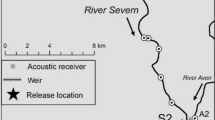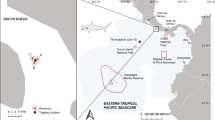Abstract
Spawning site fidelity has long been documented for anadromous salmonids, and more recently in estuarine and marine fish. The level of fidelity has implications for population dynamics, conservation, and management. This study extended a previous examination of spawning ground fidelity for common snook, Centropomus undecimalis. We used seines to sample 28 km of Gulf of Mexico beaches, spawning grounds for snook, during spawning season (May through September) from 2007 through 2010. Of 3,304 snook tagged, 171 unique fish were recaptured a total of 186 times and, of those, 166 fish (97.08%) (181 recaptures = 97.31%) were recaptured on the same island where they were tagged. One hundred seven of the recaptures occurred in the same year they were tagged, and 79 occurred one or more years after they were tagged, indicating fidelity was expressed within and across years. Distance between tag and recapture locations within and among years demonstrated fidelity at a spatial scale much smaller than barrier island (mean distance between tag and recapture =1.59 ± 0.12 km; island lengths 6.8, 8.9 and 12.4 km). Furthermore, mapping of capture locations revealed clumped distribution of snook on spawning grounds, further suggesting snook propensity for specific locations. Fish size had no effect on fidelity. We conclude that common snook show a high level of spawning site fidelity in southwest Florida, which may result in spawning group segregation, may influence the response of snook to disturbances, and may have implications for adult-to-nursery ontogenetic connections.


Similar content being viewed by others
References
Adams AJ, Dahlgren CP, Kellison GT, Kendall MS, Layman CA, Ley JA, Nagelkerken I, Serafy JE (2006) Nursery function of tropical back-reef systems. Mar Ecol Prog Ser 318:287–301
Adams AJ, Wolfe RK, Barkowski N, Overcash D (2009) Fidelity to spawning grounds by a catadromous fish, Centropomus undecimalis. Mar Ecol Prog Ser 389:213–222
Colin PL (1992) Reproduction of the Nassau grouper, Epinephelus striatus (Pisces: Serranidae) and its relationship to environmental conditions. Env Biol Fish 34:357–377
Colin PL (1996) Longevity of some coral reef fish spawning aggregations. Copeia 1996:189–192
Fowler GM, Stobo WT (1999) Effects of release parameters on recovery rates of tagged groundfish species. Can J Fish Aquat Sci 56:1732–1751
Groot C, Margolis L (1991) Pacific salmon life histories. University of British Columbia Press, Vancouver
Hammett KM (1990) Land use water use, stream flow characteristics, and water-quality characteristics of the Charlotte Harbor inflow area, Florida. Water Supply Pap US Geol Surv 2359-A.
Hanksi IA, Gilpin ME (1997) Metapopulation biology, ecology, genetics, and evolution. Academic, San Diego
Leber KM, Brennan NP, Arce SM (1995) Marine enhancement with striped mullet: are hatchery releases repleneshing or displacing wild stocks? Am Fish Soc Symp 15:376–387
Letourneur Y (1996) Dynamics of fish communities on Reunion fringing reefs. Indian Ocean. I. Patterns of spatial distribution. J Exp Mar Biol Ecol 195:1–30
Paerl HW, Bales JD, Ausley LW, Buzzelli CP, Crowder LB, Eby LA, Fear JM, Go M, Peierls BL, Richardson TL, Ramus JS (2001) Ecosystem impacts of three sequential hurricanes (Dennis, Floyd, and Irene) on the United States’ largest lagoonal estuary, Pamlico Sound, NC. Proc Natl Acad Sci USA 98:5655–5660
Peterson CH, Bishop MJ (2005) Assessing the environmental impacts of beach renourishment. Bioscience 55:887–896
Poulakis GR, Blewett DA, Mitchell ME (2003) The effects of season and proximity to fringing mangroves on seagrass-associated fish communities in Charlotte Harbor, Florida. Gulf Mex Sci 21:171–184
Robichaud D, Rose GA (2001) Multiyear homing of Atlantic cod to a spawning ground. Can J Fish Aquat Sci 58:2325–2329
Rooker JR, Stunz GW, Holt SA, Minello TJ (2010) Population connectivity of red drum in the northern Gulf of Mexico. Mar Ecol Prog Ser 407:187–196
Smedbol RK, Stephenson R (2001) The importance of managing within-species diversity in cod and herring fisheries of the north-western Atlantic. J Fish Biol 59:109–128
Swearer SE, Caselle JE, Lea DW, Warner RR (1999) Larval retention and recruitment in an island population of a coral reef fish. Nature 402:799–802
Taylor RG, Grier HJ, Whittington JA (1998) Spawning rhythms of common snook in Florida. J Fish Biol 53(3):502–520
Taylor RG, Whittington JA, Grier HJ, Crabtree RE (2000) Age, growth, maturation, and protandric sex reversal in common snook, Centropomus undecimalis, from the east and west coasts of South Florida. Fish Bull 98(3):612–624
Thorrold SR, Latkoczy C, Swart PK, Jones CM (2001) Natal homing in a marine fish metapopulation. Science 291:297–299
Tringali MD, Bert TM (1996) The genetic stock structure of common snook (Centropomus undecimalis). Can J Fish Aquat Sci 53:974–984
Willis SA, Falls WW, Dennis CW, Roberts DE, Whitchurch PG (1995) Assessment of season of release and size at release on recapture rates of hatchery-reared red drum. Am Fish Soc Symp 15:354–365
Acknowledgements
This research was funded by grants from the Florida Fish and Wildlife Conservation Commission (grant no. 06125 to R. Pierce), Mote Scientific Foundation (to AJA), and National Science Foundation REU grants to J. Gelsleichter and B. Kirkpatrik. A special acknowledgement to R. Duffey for preparing Fig. 1. We thank S. Anderson, T. Barker, N. Barkowski, R. Boucek, A. Chicone, M. Hammond, J. King, M. McGraw, J. Millar, C. Murray, C. Samoray, S. Yess, T. Yess, and J. Zehnder for field assistance, and D. R. Gulnac and D. K. Gulnac for facilities. Tagging was conducted according to standards set by the Mote Marine Laboratory Institutional Animal Care and Use Committee (IACUC permit no. 0704aa1). We are grateful for comments from two anonymous reviewers that improved the manuscript.
Author information
Authors and Affiliations
Corresponding author
Rights and permissions
About this article
Cite this article
Adams, A.J., Hill, J.E. & Samoray, C. Characteristics of spawning ground fidelity by a diadromous fish: a multi-year perspective. Environ Biol Fish 92, 403–411 (2011). https://doi.org/10.1007/s10641-011-9851-x
Received:
Accepted:
Published:
Issue Date:
DOI: https://doi.org/10.1007/s10641-011-9851-x




